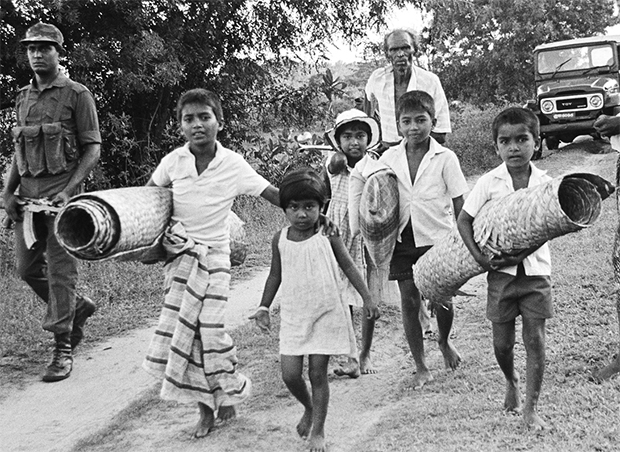The Day the Men With Guns Came to the Village
GALMETIYAWA, Sri Lanka, March 18, 1988 : Eleven-year-old Seelawathi Menike and her little brother were shooing birds away from their family’s vegetable plot when the big men in dark uniforms emerged from the jungle and began shooting.
It was about 5 o’clock in the afternoon, and the villagers were coming in from the rice fields, drawing water, starting cooking fires.
Seelawathi and her brother, 9-year-old Mahasin, crouched in the tall grass as the men walked down the dirt road talking to each other and firing at anyone they saw.
The men shot at the schoolteacher, Mr. Hemapala, and his wife as they headed down the road on his small motorcycle to bathe in a stream.
Mr. Hemapala and his wife fell off the motorcycle.

Seelawathi Menike (in hat) with her sister and brothers.
The schoolteacher picked up his wife, who had been shot in the head, and ran toward the rice field, but the men ran after him and shot him, too. Later they threw him into a well. Then the men shot another neighbor, who was riding off on a bicycle.
Seelawathi and her brother ran to the jungle and hid.
The men found one of Seelawathi’s friends hiding with his parents in a small cooking house and killed them.
Then they found three young women a little farther down the road. They raped them and then locked them in a house and burned them.
Seelawathi did not see this, but other villagers did.
Marasinghagama Tatnasari was standing in front of his house when the shooting began. He had just talked to Mr. Hemapala. When he saw the men shoot the schoolteacher, he said he realized they were Tamil guerrillas.
The guerrillas have carried out a series of attacks on Sinhalese villages this month, and many people have fled the area in fear.
The killings here in the Trincomalee District, as in much of eastern Sri Lanka, have continued, off and on, since 1983, when violence broke out between the Sinhalese ethnic majority and the Tamils, who make up 18 percent of the country’s population of 16 million.
The death toll throughout the country, mostly in attacks on settlements like this one, has mounted by 5’s and 10’s and 20’s to something like 7,000.
More than 100 people, most of them Sinhalese, have been killed this month alone, despite a peace accord signed last July that has brought at least 50,000 Indian troops to help maintain order.
When he saw the armed men kill the schoolteacher, Mr. Tatnasari took his family to hide, like Seelawathi, in the sheltering undergrowth, and so his house was empty when the men burned it.
R. D. M. Senarapbandar, who was home for a visit from his schooling as a welder, heard the armed men shouting to each other in Tamil and ran the other way, toward the Trincomalee Road a mile away.
Just at this moment, Lieut. Ruwan Kulatunga of the Sri Lankan light infantry was driving down the road with two of his men in a van.
He saw smoke rising from the burning buildings and people running toward him, and he hurried to the village.
”There were 15 to 20 of them, wearing uniforms just like us,”the lieutenant said. ”We opened fire at them.”
At this the armed men shouted, ”Soldiers,” whistled twice and disappeared into the jungle, Mr. Senarapbandar said.
Lieutenant Kulatunga found the village in a state of panic. A young woman who had witnessed the rape and killing of her friends was weeping hysterically.
The lieutenant had no radio to call for reinforcements. So he took his two men into the jungle, climbed a rocky crag, and waited quietly through the night for the raiders to return.
Even though the shooting had stopped, Seelawathi and her brother also waited through the night in the jungle, afraid to come out.
The raiders did not return, and in the morning the villagers emerged from their hiding places.
Seelawathi found her parents and her other brothers and sisters unharmed.
But the lieutenant counted 14 people killed and one boy missing. It took all day to find Mr. Hemapala’s body at the bottom of the well.
After the attack four days ago, a detachment of Sri Lankan troops moved in to secure the village.
At night, Seelawathi and her family, like their neighbors, now roll their sleeping mats under their arms and head across the rice field to the temple for safety.
The villagers tell their stories without emotion, pointing out calmly to visitors Mr. Hemapala’s motorcycle, where it still lies by the side of the road, or the small whitewashed house where the three young women were locked up and burned.
And so it seemed a little jarring today, as they gathered for the evening at the temple, when a young woman in a green dress emerged from the rice field and threw herself on the ground, wailing hysterically.
”How can I live now?” the woman cried. ”I have lost my mother, my God, my mother, how can I live without my mother?”
The villagers said that the young woman’s name was Anjee Chandrikawathi and that she had just returned home to discover that her mother had been killed.
As Miss Chandrikawathi continued to wail, sprawled in the dirt of the temple courtyard, other village women took up her cries, one of them fainting with a child in her arms, as if only now realizing what had happened to them.
Copyright The New York Times